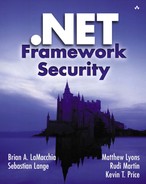Book Description
In 1997, Microsoft embarked on a "bet the company" strategy that was to reinvent the way the company did business. Even before its release, .NET made major strides in reinventing the way that software developers viewed the software they wrote.
Now that it is released, .NET and the .NET Framework will change the software development process for good.
.NET Framework Security provides the ultimate high-end comprehensive reference to all of the new security features available in .NET. Through extensive code samples and step-by-step walkthroughs of configuration techniques, the reader is taken deep into the world of secure applications. Demonstrations of creating custom procedures and a full explanation of each aspect separate this book from many other "lecture books." Many of the concepts expressed in this book are not only viable in .NET, but on the Internet in general. These factors combined make this the one reference that every developer and system administrator should have.
.NET Framework Security provides
An extensive introduction to explanation of Code Access Security, the powerful new security system shipping in the .NET Framework
Information on how to write and test safe applications using the .NET Framework
Extensive coverage on how to effectively administer .NET Framework security
In-depth introduction to the cryptography library shipping in the .NET Framework, including an introduction to XML digital signatures
An overview of all of the new security features available in .NET
Code samples that can be used to implement security on your own Web site or application
Step-by-step guidelines for modifying the various configuration files associated with .NET, and an explanation of the elements involved
Instructions for all of the aspects of security in the CLR and what it means
How to use ASP.NET to create a secure application
Explanations for using the CryptoAPI libraries to create your own custom functionality
Guidelines on how to create secure network applications as well as applications that exist on the Internet
Detailed examples of how to establish security parameters in IIS that relate to ASP.NET
Instructions for administering .NET applications hosted in IE
067232184XB04232002
Table of Contents
- Copyright
- About the Authors
- Acknowledgments
- Introduction
- Introduction to the .NET Developer Platform Security
- Code Access Security Fundamentals
- User- and Code-Identity–Based Security: Two Complementary Security Paradigms
- Evidence: Knowing Where Code Comes From
- Permissions: The Workhorse of Code Access Security
- Walking the Stack
- Membership Conditions, Code Groups, and Policy Levels: The Brick and Mortar of Security Policy
- Understanding the Concepts of Strong Naming Assemblies
- Hosting Managed Code
- Verification and Validation: The Backbone of .NET Framework Security
- Security Through the Lifetime of a Managed Process: Fitting It All Together
- ASP.NET and Web Services Security Fundamentals
- .NET Framework Security Administration
- Introduction: .NET Framework Security and Operating System Security
- Administering Security Policy Using the .NET Framework Configuration Tool
- Before Making Any Security Policy Change: Administration Strategies
- Introduction to the .NET Framework Configuration Tool
- Increasing Trust for an Assembly or Software Publisher Using the Trust Assembly Wizard
- Changing Trust for a Zone Using the Adjust Security Wizard
- Manipulating the Security Policy Tree Directly—Basic Techniques
- Testing Security Policy Using the Evaluate Assembly Wizard
- Modeling Policy Changes Using Open and New
- Deploying Security Policy
- Resetting Security Policy
- The .NET Framework Configuration Tool's Self Protection Mechanism
- Administrative Tactics: Scenarios, Solutions, Hints, and Tricks
- Summary
- Administering .NET Framework Security Policy Using Scripts and Security APIs
- Administering an IIS Machine Using ASP.NET
- Administering Clients for .NET Framework Mobile Code
- Administering Isolated Storage and Cryptography Settings in the .NET Framework
- .NET Framework Security for Developers
- Creating Secure Code: What All .NET Framework Developers Need to Know
- Architecting a Secure Assembly
- Implementing a Secure Assembly
- Testing a Secured Assembly
- Writing a Secure Web Site Using ASP.NET
- Writing a Secure Web Application in the .NET Development Platform
- Writing a Semi-Trusted Application
- Using Cryptography with the .NET Framework: The Basics
- Setting the Stage: Key Definitions and Scenarios in Cryptography
- The Cryptographic Object Model of the .NET Framework
- Operating on Streams: CryptoStreams and ICryptoTransforms
- Using Symmetric Algorithms
- Using Cryptographic Hash Functions
- Using Keyed Hash Functions
- Random Number Generation and Key Derivation
- Using Asymmetric Algorithms
- Summary
- Using Cryptography with the .NET Framework: Advanced Topics
- Using Cryptography with the .NET Framework: Creating and Verifying XML Digital Signatures
- Index
